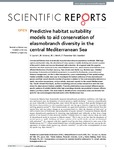Predictive habitat suitability models to aid conservation of elasmobranch diversity in the central Mediterranean Sea
| dc.contributor.author | Lauria, V | |
| dc.contributor.author | Gristina, M | |
| dc.contributor.author | Attrill, MJ | |
| dc.contributor.author | Fiorentino, F | |
| dc.contributor.author | Garofalo, G | |
| dc.date.accessioned | 2017-04-27T12:59:24Z | |
| dc.date.available | 2017-04-27T12:59:24Z | |
| dc.date.issued | 2015-10 | |
| dc.identifier.issn | 2045-2322 | |
| dc.identifier.issn | 2045-2322 | |
| dc.identifier.other | 13245 | |
| dc.identifier.uri | http://hdl.handle.net/10026.1/9135 | |
| dc.description.abstract |
<jats:title>Abstract</jats:title><jats:p>Commercial fisheries have dramatically impacted elasmobranch populations worldwide. With high capture and bycatch rates, the abundance of many species is rapidly declining and around a quarter of the world’s sharks and rays are threatened with extinction. At a regional scale this negative trend has also been evidenced in the central Mediterranean Sea, where bottom-trawl fisheries have affected the biomass of certain rays (e.g. <jats:italic>Raja clavata</jats:italic>) and sharks (e.g. <jats:italic>Mustelus</jats:italic> spp.). Detailed knowledge of elasmobranch habitat requirements is essential for biodiversity conservation and fisheries management, but this is often hampered by a poor understanding of their spatial ecology. Habitat suitability models were used to investigate the habitat preference of nine elasmobranch species and their overall diversity (number of species) in relation to five environmental predictors (i.e. depth, sea surface temperature, surface salinity, slope and rugosity) in the central Mediterranean Sea. Results showed that depth, seafloor morphology and sea surface temperature were the main drivers for elasmobranch habitat suitability. Predictive distribution maps revealed different species-specific patterns of suitable habitat while high assemblage diversity was predicted in deeper offshore waters (400–800 m depth). This study helps to identify priority conservation areas and diversity hot-spots for rare and endangered elasmobranchs in the Mediterranean Sea.</jats:p> | |
| dc.format.extent | 0-0 | |
| dc.format.medium | Electronic | |
| dc.language | en | |
| dc.language.iso | en | |
| dc.publisher | Springer Science and Business Media LLC | |
| dc.subject | Animals | |
| dc.subject | Biodiversity | |
| dc.subject | Computer Simulation | |
| dc.subject | Conservation of Natural Resources | |
| dc.subject | Ecosystem | |
| dc.subject | Elasmobranchii | |
| dc.subject | Environmental Monitoring | |
| dc.subject | Mediterranean Sea | |
| dc.subject | Models, Statistical | |
| dc.title | Predictive habitat suitability models to aid conservation of elasmobranch diversity in the central Mediterranean Sea | |
| dc.type | journal-article | |
| dc.type | Article | |
| plymouth.author-url | https://www.ncbi.nlm.nih.gov/pubmed/26272502 | |
| plymouth.issue | 0 | |
| plymouth.volume | 5 | |
| plymouth.publication-status | Published online | |
| plymouth.journal | Scientific Reports | |
| dc.identifier.doi | 10.1038/srep13245 | |
| plymouth.organisational-group | /Plymouth | |
| plymouth.organisational-group | /Plymouth/Faculty of Science and Engineering | |
| plymouth.organisational-group | /Plymouth/Faculty of Science and Engineering/School of Biological and Marine Sciences | |
| plymouth.organisational-group | /Plymouth/PRIMaRE Publications | |
| plymouth.organisational-group | /Plymouth/REF 2021 Researchers by UoA | |
| plymouth.organisational-group | /Plymouth/REF 2021 Researchers by UoA/UoA07 Earth Systems and Environmental Sciences | |
| plymouth.organisational-group | /Plymouth/Users by role | |
| plymouth.organisational-group | /Plymouth/Users by role/Academics | |
| dc.publisher.place | England | |
| dcterms.dateAccepted | 2015-07-10 | |
| dc.identifier.eissn | 2045-2322 | |
| dc.rights.embargoperiod | Not known | |
| rioxxterms.versionofrecord | 10.1038/srep13245 | |
| rioxxterms.licenseref.uri | http://www.rioxx.net/licenses/all-rights-reserved | |
| rioxxterms.licenseref.startdate | 2015-10 | |
| rioxxterms.type | Journal Article/Review |


